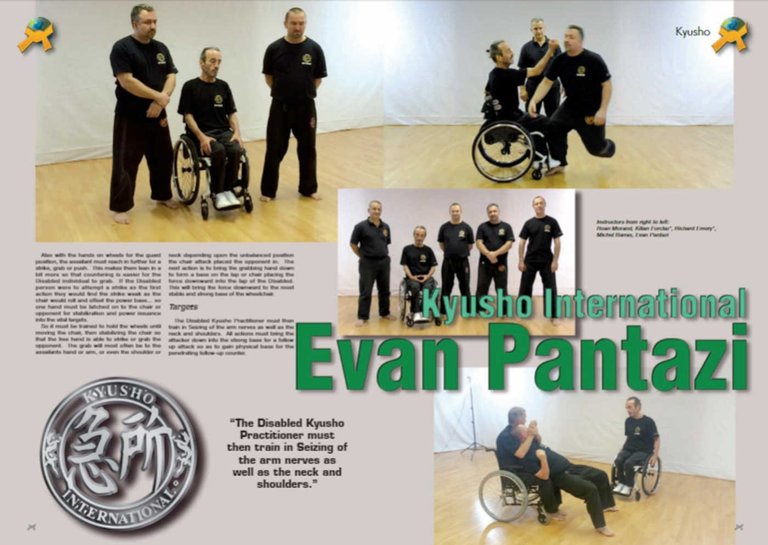
The Approach
Kyusho is perfectly suited for people with all ranges of disability, in fact it is far better suited than most Martial Arts out there as it uses far less power, speed and especially agility. It also has greater effect on the assailant as the weaker anatomical structures are targeted as opposed to general areas.
What needs to be realized by all those not disabled, is the limitations on mobility and agility as they are often constrained by the individuals disability. One of the more difficult disabilities is in the mobility lost during confinement in a wheelchair. You do not have a stable base from which to issue a powerful technique or counter. You are always at risk of tipping over, or rolling away or into the attack. The strikes if power based, propel the chair backward which could be devastating if there were a curb, pothole or some other terrain difficulty. If the individual in the wheelchair is grabbed, or grabs the assailant, they also lose control of their position, mobility, direction, base and are even more at risk and endangered.
Applicable Tools
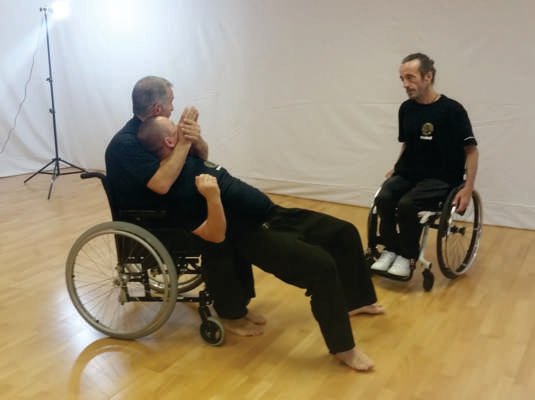
Since the wrists are strong and developed as are the arms, the strikes of the hands to vital structures also carry great dysfunctional possibility. This is in part enabled by the snap in the wrist that helps penetrate to the inner vital anatomical structures, to cause an over stimulation of the nerve system of the opponent upon impact.
So yes a disabled individual has fewer possibilities in tools, but what they do maintain, gets stronger and can be transformed easily into very destructive weapons.
Strategies
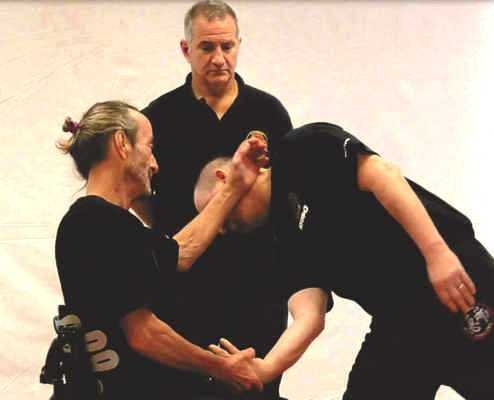
As example a on guard position for Boxers, Grapplers or any Martial Artist, is to put the hands up to protect the head, neck and upper body. For a Disabled individual in a wheelchair, this is not sound advice. It is far better to have their hands on the wheels for fast inward, rearward, lateral or spinning motion. Using the chair as the first attack on the opponents ankles and or legs, will weaken as well as surprise for the would be attacker.
The foot rests of the typical wheelchair, are around the same height from the ground as are the more vulnerable nerves, tendons and blood vessels of the opponents ankles. Slamming the chair into the ankles will cause intense pain and dysfunction of the opponent. This in turn will cause weakening of the attack as well as their balance and power base.
Also with the hands on wheels for the guard position, the assailant must reach in further for a strike, grab or push. This makes them lean in a bit more so that countering is easier for the Disabled individual to grab. If the Disabled person were to attempt a strike as the first action they would find the strike weak as the chair would roll and offset the power base… so one hand must be latched on to the chair or opponent for stabilization and power issuance into the vital targets.
So it must be trained to hold the wheels until moving the chair, then stabilizing the chair so that the free hand is able to strike or grab the opponent. The grab will most often be to the assailants hand or arm, or even the shoulder or neck depending upon the unbalanced position the chair attack placed the opponent in. The next action is to bring the grabbing hand down to form a base on the lap or chair placing the force downward into the lap of the Disabled. This will bring the force downward to the most stable and strong base of the wheelchair.
Targets
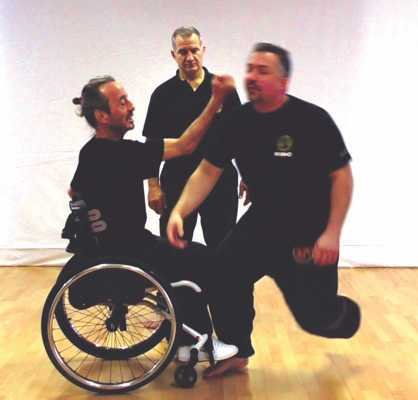
These are the targets that will be most easily accessible and functional for the counter. The opponents body will be folding from either the ankle ram or the seizing of the arm nerves, even with seizing the head or neck targets. So study on the body should be much later in the study for the disabled, as should the leg targets.
Tuite
Once the Disabled Practitioner gains skill and spontaneity with their protection methods, they can then learn the more sophisticated joint attacks (utilizing the nerves). The Disabled Practitioners strengthened grip will then become a very useful tool on the opponent, with the ability to control or damage.
The use of Tuite will be profound if the practitioner can employ them as they affect the opponents balance and nerve system to a higher degree. That will make any subsequent strikes to head or neck far more powerful and effective.
Course Designers
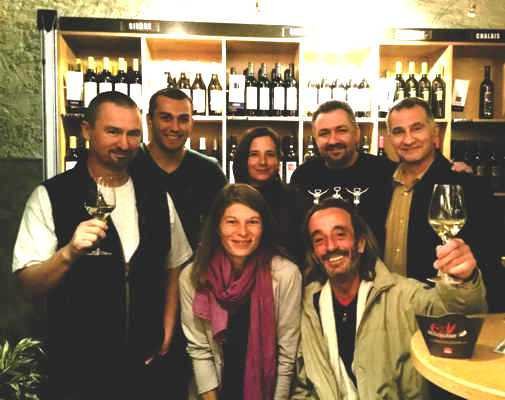
Now I had worked with Disabled individuals before, but not on a constant basis and not for many years, save a few attending seminars. Michel (pictured above, has disability with legs, hips and lower torso) had just started his Kyusho Journey with Richard Emery and during the filming, he did a remarkable job trying to assimilate the ideas that were not yet in his level of expertise. As we continue to work with disabled people, we gain so many insights… this is an invaluable program for any Martial Arts Instructor… and especially for those with disabilities.
Kyusho is the Equalizer
Kyusho has been prized for centuries by the Masters of Old as they fully kept their prowess even in advanced years. The understanding of the human anatomy, physiology and functionality, need not be kept private for selected family members, favored students or inheritors of the style. This is vital information and skill development for all ages… and aging. It is the equalizer that the Martial Arts were intended to be.
.
.
.

Image Credit: Roan Morand
Good Health – Evan Pantazi #Kyusho
very good ... i like it is same as texido ???
@kyusho
😄🤼
Just mind over circumstance... I guess the adage, "mind over matter" is the Vital Point that matters.
ok ok
If you want to succeed, we must work together
good food for sure. I would love it, if there is time I will travel there, enjoy it thank you already share @kyuso, @ jhoni is your vote, and will always be present for you although late, sorry was wrong typed.
I don't know about deadly as much as it being more of an equalizer for those that use it.
In every disability, there is an ability after all. Most disabled individual will be thinking there is no means of personally protecting themselves from attacks.
I long does teaching kyusho to an individual takes?
It as always depends on the individual as to how fast they will learn. I worked with a man that was paraplegic, he would ascend stairs in his chair and get into his specially equipped vehicle so adeptly that I was in awe. He studied Jujitsu and would get out of the chair at times to grapple on the ground. If he got you, the power in his arms and the determination in his mind were inescapable.
Wow, i am impressed. I think i will read more on it. I hope can find information online.
https://kyusho.com/h/?s2-ssl=yes
Thank you for this
It would be great if you could go the opposite way... video to text as well.